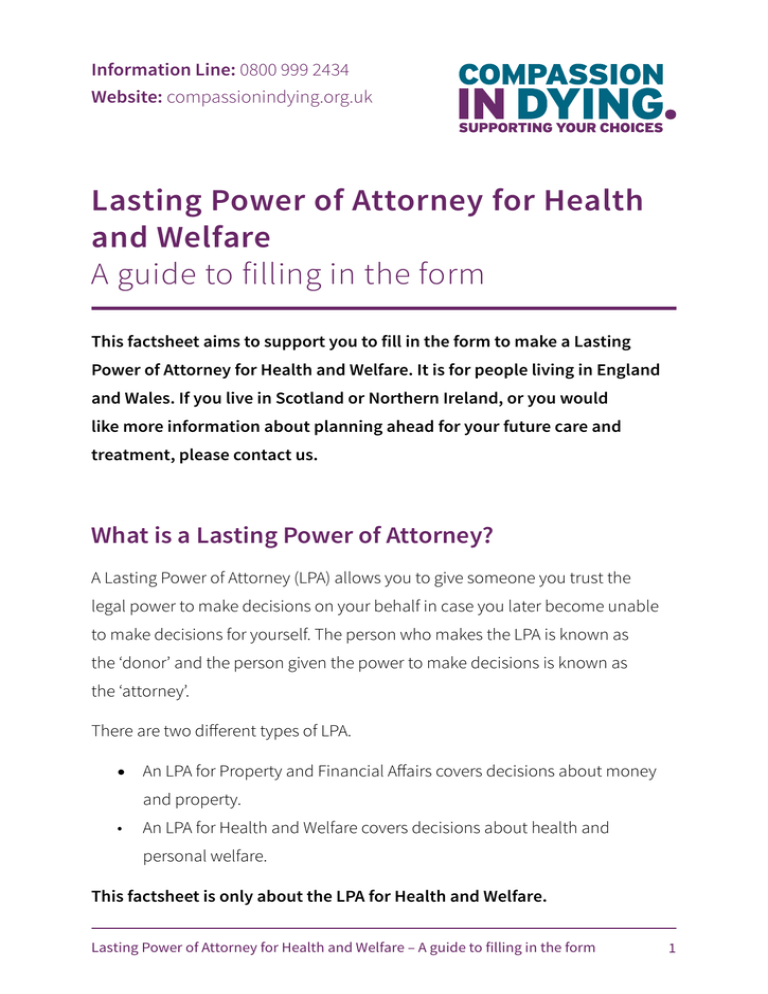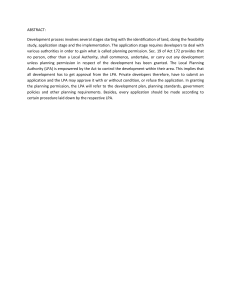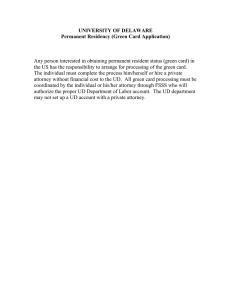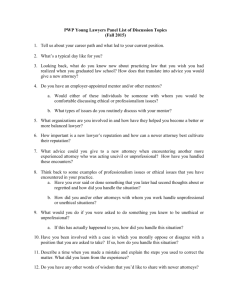
Information Line: 0800 999 2434
Website: compassionindying.org.uk
Lasting Power of Attorney for Health
and Welfare
A guide to filling in the form
This factsheet aims to support you to fill in the form to make a Lasting
Power of Attorney for Health and Welfare. It is for people living in England
and Wales. If you live in Scotland or Northern Ireland, or you would
like more information about planning ahead for your future care and
treatment, please contact us.
What is a Lasting Power of Attorney?
A Lasting Power of Attorney (LPA) allows you to give someone you trust the
legal power to make decisions on your behalf in case you later become unable
to make decisions for yourself. The person who makes the LPA is known as
the ‘donor’ and the person given the power to make decisions is known as
the ‘attorney’.
There are two different types of LPA.
•• An LPA for Property and Financial Affairs covers decisions about money
and property.
•• An LPA for Health and Welfare covers decisions about health and
personal welfare.
This factsheet is only about the LPA for Health and Welfare.
Lasting Power of Attorney for Health and Welfare – A guide to filling in the form
1
This factsheet offers information on how to complete the LPA for Health and
Welfare form. Our factsheet Lasting Power of Attorney for Health and Welfare –
An introduction offers more general information on what an LPA is, the people
involved and who you can choose as your attorney.
How do I make an LPA?
There are three key steps to making an LPA.
1. Choose your attorney and the other people involved (see below)
2. Complete the form (available from the Office of the Public Guardian (OPG))
3. Register the form with the OPG
An LPA must be registered with the OPG before it can be used. The OPG is part of
the government’s Ministry of Justice department. It manages the LPA registration
process and has a register of all LPAs. It can also investigate if somebody has
concerns about the way an attorney is acting.
The OPG produces Guidance Notes to making an LPA, which should be read
together with this factsheet.
The LPA forms changed on 1st July 2015. If you have the old version, you will
only be able to register it if all sections have been completed before 1st January
2016. If you are unsure which version you have, please contact us.
Who are the people involved in making an LPA?
There are a number of people involved in making an LPA. They are:
The donor
The donor is the person making the LPA (you).
Lasting Power of Attorney for Health and Welfare – A guide to filling in the form
2
Your attorney
Your attorney can make decisions about anything to do with your health and
personal welfare. They can be anyone over the age of 18, such as a partner,
family member or friend. Your attorney will only be able to make decisions for
you if you can no longer do so yourself.
You can choose more than one attorney. There is no limit to the number of
attorneys you can have. You can also choose one or several replacement
attorneys who will take over if your original attorney cannot continue to act.
Certificate provider
The certificate provider is an independent person who signs the LPA form to
check that you understand what you are doing and that nobody is putting
pressure on you to make the LPA. They can either be someone who has known
you well for at least two years (like a friend or neighbour), or a professional (like
a doctor or solicitor).
A certificate provider cannot be:
•• under 18;
•• a family member of you, your attorney or replacement attorney;
•• a business partner or paid employee of you, your attorney or
replacement attorney;
•• your attorney or replacement attorney; or
•• the owner, director, manager or an employee of a care home in which
you live or a member of their family.
A full list of who can and cannot be a Certificate Provider can be found on page
38 of the OPG’s Guidance Notes.
Lasting Power of Attorney for Health and Welfare – A guide to filling in the form
3
People to be notified
On the LPA form, you have the option to list up to five people who will be
notified that you are making the LPA when it is sent to be registered. They do
not have to sign the form itself but you have to send them a notification letter
when you register the LPA. They are then given three weeks to say if they have
any concerns or objections. This helps to check that you are not being put under
pressure to make the LPA.
Naming people to be notified is optional, so you do not have to name anyone if
you do not want to.
Witnesses
Somebody must act as a witness when you and your attorney sign the LPA form.
This means that they must watch you sign and then they must also sign the
form. The person who witnesses your signature can be different from the person
who witnesses your attorney’s signature.
The person who witnesses your signature must be over the age of 18 and cannot
be one of your attorneys or replacement attorneys. Your witness can be the
same person as your certificate provider.
How can I get an LPA form?
You can get an LPA form in one of three ways:
a) ask the OPG to send the form to you (contact details are at the end of this
factsheet);
b) download it from their website here www.gov.uk/government/publications/
make-a-lasting-power-of-attorney; or
c) complete it online using their digital tool here www.lastingpowerofattorney.
service.gov.uk/home
Lasting Power of Attorney for Health and Welfare – A guide to filling in the form
4
Filling in the LPA form
The form has 15 sections. There are also continuation sheets that you must fill
in if there is extra information you need to include that does not fit onto the
form. You must use the correct continuation sheet for the section that you are
filling in. You should not write additional information on anything other than the
continuation sheets that are provided by the OPG.
Continuation Sheet 1 - “Additional People” allows you to nominate more
attorneys or replacement attorneys.
Continuation Sheet 2 - allows you to give more information on how you would
like attorneys to make decisions.
Section 1: The donor (you)
In this section you fill in your own details (including your full name, address and
date of birth).
Section 2: The attorneys
In this section you fill in your attorney’s details (including their full name, address
and date of birth). There is space on the form to choose up to four attorneys.
If you would like more than four, you must use Continuation Sheet 1 to record
their details.
Section 3: How should your attorneys make decisions?
In this section you can choose how you would like your attorneys to act. If you
have only one attorney, you must tick the box at the top of the page. If you have
more than one attorney, your attorneys can act in one of three ways:
•• Jointly and severally – If you choose for your attorneys to act ‘jointly
and severally’ then they can act together but they can also act on their
own. This means, for example, that if you were in hospital and a decision
needed to be made on your behalf but the doctors could only get in
Lasting Power of Attorney for Health and Welfare – A guide to filling in the form
5
contact with one of your attorneys, then that one attorney could still
make the decision for you.
If you choose for your attorneys to act jointly and severally it also means
that if one attorney is unable to act, for example because they have
died, the remaining attorneys will still be able to act. If you have chosen
any replacement attorneys, they can step in to act with the remaining
attorneys.
•• Jointly – If you choose for your attorneys to act jointly then your
attorneys must make decisions together and agree unanimously on all
the decisions they make. This means that if you were in hospital and a
decision needed to be made on your behalf but the doctors could only
get in contact with one of your attorneys, then that one attorney would
not be able to make the decision for you because all attorneys have to
agree before any action can be taken.
If you choose for your attorneys to act jointly it also means that if one
attorney is unable to act, for example because they have died, then your
LPA will become invalid and the remaining attorneys will not be able to
make decisions for you. If you have chosen any replacement attorneys,
they will step in to act alone.
•• Jointly for some decisions, and jointly and severally for other
decisions – This means you can specify decisions that must be made
together and the decisions where the attorneys can act alone. If you
choose this option, you must write the decisions that must be made
together on Continuation Sheet 2.
If you have more than one attorney, you cannot give a particular decision to a
particular attorney. So, for example, you could not say that any decisions about
your medical treatment must only be made by your first attorney.
Lasting Power of Attorney for Health and Welfare – A guide to filling in the form
6
When filling in the form if you do not specify how your attorneys must act, they
will have to act jointly.
Section 4: Replacement attorneys
In this section you fill in the details of any replacement attorneys (including their
full name, address and date of birth). Choosing a replacement attorney means
that if one of your original attorneys is unable to act, your LPA can still be used
because you have a replacement person to step in. A replacement attorney can
only make decisions when an original attorney cannot do so.
If you leave Section 4 blank, your LPA will end when your original attorneys can
no longer act for you.
There is space on the form to choose up to two replacement attorneys. If you
would like more than two, you must use Continuation Sheet 1 to record their
details.
Section 5: Life-sustaining treatment
In this section you must choose whether or not to give your attorneys power to
make decisions about life-sustaining treatment. You must choose only
one option.
If you choose Option A, your attorneys will be able to give or refuse consent
to life-sustaining treatment on your behalf.
If you choose Option B, your attorneys will not be able to give or refuse consent
to life-sustaining treatment on your behalf. All decisions about life-sustaining
treatment would instead be made by your healthcare team, unless you had
made an Advance Decision to Refuse Treatment. See our factsheet Advance
Decisions (Living Wills) - An Introduction for more information.
Life-sustaining treatment could include things like cardiopulmonary
resuscitation if your heart stops, being put on a ventilator if you cannot breathe
Lasting Power of Attorney for Health and Welfare – A guide to filling in the form
7
on your own, or being given food and fluids through tubes or through a drip
(artificial nutrition and hydration).
Section 6: People to notify when the LPA is registered
In this section you fill in the details of the people who you choose to be notified
when the LPA is registered. There is space on the form to write the details of
four people to be notified. If you choose more than four people you must use
Continuation Sheet 1. You can choose a maximum of five people to be notified.
Naming people to be notified is optional, so you do not have to name anyone if
you do not want to.
Section 7: Preferences and Instructions
In this section you write any preferences and instructions that you would like
your attorney to follow.
Preferences
Preferences are things that you would like your attorneys to take into account
when making decisions on your behalf, for example ‘I prefer to avoid being
admitted to hospital where possible.’
Words like must, shall not and cannot can only be used in the instructions and
not in the preferences. This is because these words are a direct instruction to
the attorney, rather than information you want them to know. Using these kinds
of words in preferences could cause a delay in the LPA being registered. This is
because the OPG will have to remove them.
Instructions
Instructions are things that your attorney must follow. An example of an
instruction is saying that your attorney must refuse certain treatments on your
behalf, for example ‘my attorney must not consent to treatment involving
blood products.’
Lasting Power of Attorney for Health and Welfare – A guide to filling in the form
8
You cannot include instructions that are not possible to follow, that contain
anything illegal or that give decision-making power to a person other than
your attorney.
This section is optional. You do not have to fill in any instructions or preferences
if you do not want to.
Section 8: Your legal rights and responsibilities
This section contains information that must be read by all of the people involved
in the LPA.
Signing your LPA
Once you have filled in Sections 1 to 8 of the form it must be signed by you,
your attorneys and any replacement attorneys, and your certificate provider.
Everyone can sign the form at the same time. However, if the form is not signed
by everyone at the same time (for example if they sign on different days) then
each part must be signed in a certain order.
Section 9: Signature: donor (you)
You must sign and date Section 9. Someone must witness you doing this, and
they must then also sign and date this section. If you have used any continuation
sheets then you must also sign and date these pages at the same time as you
sign Section 9.
If you are unable to sign for yourself, you can make a mark or direct someone to
sign for you in the presence of a witness.
Section 5: Signature: donor (life-sustaining treatment)
You must sign and date Section 5 to choose whether or not you give your
attorney power to make decisions about life-sustaining treatment. You must
Lasting Power of Attorney for Health and Welfare – A guide to filling in the form
9
sign this section at the same time as Section 9. Someone must witness you
doing this, and they must also sign and date this section.
Section 10: Signature: certificate provider
The certificate provider must fill in their own details and sign and date section 10.
Section 10 of the form must be signed by your certificate provider at the
same time or AFTER Section 9 has been signed.
Section 11: Signature: attorneys
Your attorneys and any replacement attorneys must sign and date Section 11.
Each person needs to complete Section 11 individually.
Someone must witness each attorney and replacement attorney signing, and
the witness must then also sign and date this section. If you have more than one
attorney they can each have a different witness. The attorneys can also witness
each other’s signatures.
Section 11 of the form must be signed after both Sections 9 and 10 have
been signed.
Registering your LPA
The LPA can be registered by you (while you have capacity) or by your attorneys
(at any time). If your attorneys have been appointed jointly, they must all apply
to register the LPA.
You do not have to register your LPA straight away but it is recommended that
you do so. This is because any mistakes in the form can be corrected while you
still have capacity. If your LPA is not registered until you lose capacity and it
contains mistakes that mean your form cannot be registered, you will not be
able to correct these mistakes and your LPA will be invalid. Registering your LPA
Lasting Power of Attorney for Health and Welfare – A guide to filling in the form
10
straight away also means that there will be no delay when it needs to be used
because you will not have to wait for it to be registered.
Once Sections 1 to 11 of the LPA form have been completed and signed by
everyone then Sections 12 to 15 must be completed in order to register it. These
sections must be completed by the person who is applying to register the LPA.
Once your LPA has been registered by the OPG they will return the form to you
(or to the attorney if they registered it). It will be stamped on every page and it is
only valid once this is done.
Registration can take up to three months.
Section 12: The applicant
In this section the person applying to register the LPA must fill in their details
(including their full name, address and date of birth). This can either be you (the
donor) or your attorney. If you have chosen for your attorneys to act jointly, they
must all apply to register the LPA.
Section 13: Who do you want to receive the LPA?
In this section the person applying to register the LPA must choose who will
receive the original document once it has been registered.
Section 14: Application fee
In this section you must choose how you are going to pay the registration fee. It
costs £110 to register an LPA. You can pay by cheque or by card. If you choose
to pay by card, you must include your telephone number and the OPG will
contact you to take the payment. If you choose to pay by cheque you must
include a cheque made payable to the ‘Office of the Public Guardian’ with your
application.
Depending on your situation you may be able to pay a reduced amount or be
able to pay nothing. If you have an income under £12,000 or are on certain
Lasting Power of Attorney for Health and Welfare – A guide to filling in the form
11
benefits you can apply for a reduction. If you would like to apply for a reduction,
you must fill in a separate form called LPA120 and send it (along with proof that
you qualify for the reduction) to the OPG when you apply to register the LPA.
Section 15: Signature
This section must be signed by the person applying to register the LPA. If the
attorneys have been appointed jointly and they are applying to register the LPA,
they must all sign this section.
Can I change my mind?
Yes, while you have capacity you can change your mind at any time and cancel
the LPA. If it has not been registered, you can destroy the document and should
inform anybody involved in the LPA that you have done so. If you have already
registered the LPA, you must contact the OPG.
How can we help?
If you have any questions about Advance Decisions, Lasting Powers of Attorney,
planning ahead or decision making more generally then please contact our
Information Line (our contact details are on the next page).
We can send you a copy of Planning Ahead: Making Choices for the End of Life, a free
and comprehensive guide to planning ahead for your future care and treatment
The following Compassion in Dying factsheets may also be helpful:
•• Lasting Powers of Attorney for Health and Welfare - An introduction
•• Advance Decisions and Lasting Powers of Attorney for Health and Welfare –
What is best for me and can I have both?
•• Advance Decisions (Living Wills)
Lasting Power of Attorney for Health and Welfare – A guide to filling in the form
12
Further sources of help
Office of the Public Guardian:
To contact the Office of the Public Guardian directly:
Tel: 0300 456 0300
Web: www.publicguardian.gov.uk
All the forms mentioned here are available from the Office of the Public
Guardian’s website: www.gov.uk/government/collections/lasting-power-ofattorney-forms
They are also available in accessible format by ringing 0300 456 0300
To access the online tool visit: www.gov.uk/lasting-power-of-attorney
Lasting Power of Attorney for Health and Welfare – A guide to filling in the form
13
Every effort has been made to ensure that the information provided in this
factsheet is accurate and up-to-date, but information can change over time.
Compassion in Dying does not accept any liability arising from its use, and it
should not be used as an alternative to legal or medical advice. You can find the
latest version of this publication on our website.
© Compassion in Dying, 2015. All rights reserved. Except for personal use, no
part of this work may be distributed, reproduced, downloaded, transmitted or
stored in any form without the written permission of Compassion in Dying.
Registered charity no. 1120203. A company limited by guarantee and
registered in England no. 05856324.
Contact our Information Line:
Phone: 0800 999 2434
10am -4pm Monday -Friday
Email: info@compassionindying.org.uk
Address: Compassion in Dying
181 Oxford Street, London W1D 2JT
Factsheet code:
LPA04
Publication or last review date:
September 2015
Next review due:
September 2018
Version number:
5
Compassion in Dying supports people
to plan ahead to ensure their wishes
for treatment and care are respected.
A list of references is available on request
Lasting Power of Attorney for Health and Welfare – A guide to filling in the form
14



